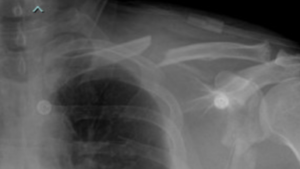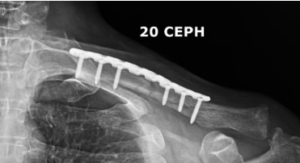Clavicle Fracture (Broken Collarbone)
What is a Clavicle Fracture?
A clavicle fracture is a broken collarbone. This can occur in patients of all ages from a variety of traumatic causes, and is a very common injury.

Reproduced with permission from OrthoInfo. © American Academy of Orthopaedic
Surgeons. https://orthoinfo.org/
What does the Clavicle do?
The collarbone is a structure that serves as a strut to the shoulder. It helps keep your arm in the right position for overhead activity and allows your muscles to be under the correct tension to maintain strength.
Clavicle Fracture Diagnosis and Examination
Physical examination is important in the evaluation of these injuries. Important blood vessels and nerves lie underneath the collarbone and can be injured when it breaks. The doctor will also look for any open wounds over the injury. Sometimes the bone pushes against the skin causing it to “tent.” Too much pressure can result in the bone coming through the skin.
X-rays are used to evaluate the location, type, and severity of the broken bone. This helps doctors and patients make an informed decision on treatment. Often 2 or more x-rays are taken in the standing position to show the injury pattern.

Preoperative x-ray of clavicle fracture.
Non-Surgical Treatment for Clavicle Fractures
Clavicle fractures do not always require surgery. Many heal just fine without an operation. Minor fractures with minimal displacement do very well with nonsurgical treatment. Science has shown that there is no difference in use of a sling, shoulder immobilizer or figure-of-eight brace. These devices are used for support and comfort only.
If non-operative care is chosen, regular follow-up care for a physical exam and xrays is important to ensure that the fracture stays in good position and heals appropriately. Cutting down or quitting smoking and tight blood sugar control if you are a diabetic is important for the healing process.
Surgical Treatment for Broken Collarbones
Surgeons may recommend an operation to fix the broken collarbone if it is broken into many pieces, if the bones are far apart, if the bone sticks out through the skin, or if the nerves or blood vessels are injured. Several studies have shown that surgery helps reduce pain, get people back to work sooner and maintains shoulder strength and motion.
Broken clavicles can be fixed with plates and screws or pins. Plates and screws require bigger incisions but ensure that the bone is lined up perfectly. Pins use smaller incisions but have been associated with higher complication rates. Surgery takes under an hour and can often be done on a “same day” or outpatient basis. Ideally, surgeons like to perform surgery within 1-2 weeks of injury. Thus, patients have time to seek a second opinion regarding treatment if more information or additional surgeon input is desired.
It is important to choose your surgeon wisely. The lung and several important blood vessels and nerves lie underneath the collarbone. It is possible for these to be injured during surgery. Extensive surgical experience can be helpful in achieving a good result and avoiding complications. Collectively, ROC orthopedic surgeons have performed more clavicle operations than any practice in Northern Nevada and take pride in outstanding surgical results.
After surgery, patients are allowed to use their arm for gentle activities and a sling for comfort only. Weight-bearing is limited to a few pounds overhead and patients with multiple injuries can use crutches safely. Initial range-of-motion exercises are encouraged.

Postoperative x-ray of clavicle fracture repair.
Surgical Complications
Complications can occur with any surgery, no matter how small. There is always a risk of infection. A dose of antibiotics given prior to surgery helps to make this risk as small as possible. There is always a risk of injury to blood vessels or nerves. This is reduced by having an experienced surgeon involved in your care. The lung also lies close to the collarbone. It is possible to create an injury to the lung during surgery. Patients are observed closely in the recovery room after surgery before going home. If any breathing problems arise after surgery, patients are instructed to go immediately to the closest hospital emergency room. Finally, it is always possible that the bone may not heal. This is usually associated with patient noncompliance, diabetes, or use of nicotine like smoking and chewing tobacco.
Clavicle Nonunion or Malunion
Patients who decide not to have surgery on their broken collarbone can develop a nonunion or a malunion. A nonunion is when the bone does not heal after 6 months. A malunion is when the bone heals but in a bad position. Both of these conditions can be treated with surgery if a patient has persistent pain and dysfunction. This often involves placement of plates and screws and can require bone grafting from the hip or pelvis.
Outcomes
Most people with collarbone fractures do very well. By six weeks, patients are extremely comfortable and usually are released to full activities such as manual labor, skiing and motocross by three months. Aggressive return to activity too early can result in re-fracture, hardware breakage or nonunion. If you have had surgery, sometimes the metal becomes painful. This can be removed one year after surgery.
